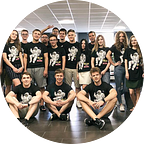Business Before Technology — What Does It Mean?
Implementing your idea into reality requires a lot of effort. You should write a business plan, think over all the functionality you want the app to perform, take into account some marketing strategies, analyze your competitors and a target audience, and then turn to the developers.
Many digital agencies that work with web and mobile development focus only on the tech side of outsourcing projects. They just listen to the requirements, take the task, and do whatever they’re told to do. They don’t get into details of how to make it more successful, they just perform their duties and get the money.
But what if a development agency can become your guide to a successful business? Here we are to explain how it’s possible!
What does it mean?
The article is called “Business before technology”. What do we mean when we say something like that?
Let’s imagine a situation: A client comes to a software development agency with the best idea ever. In the first meeting, they explain what they want, sometimes in poor detail, and expect the developers to do it exactly as they imagine it.
That’s the best place to stop and think, together with the development team. Even if you’re absolutely sure about what you want to build, it’s better to receive a third-party view on your idea. There are several questions that should be asked before the project goes to developers:
- What do you want?
- Why do you want it?
- What are your goals?
- What are your alternatives?
These questions can drastically change the initial view you had on a product, even to the point of absolutely rethinking the idea! For example, a client comes with an idea of a huge mobile app with vast functionality, but after a discussion and analysis with the whole development team, the app can easily turn into a simple website or just a landing page.
Why it is cool
Such an approach to web and mobile development benefits both sides of the project, the client and the development team. The developers try not only to complete the task but to understand its deeper meaning: Why will the future users need this or that function? Does the team really need to implement it at this stage? Is it possible to facilitate its creation?
It happens with every project to varying degrees. Sometimes the final version barely changes, sometimes the product looks absolutely different from the first plans. The number of changes the app goes through depends highly on what the current stage of the project is. When a client comes with a detailed plan or a ready prototype, it’s hard to implement big changes. But if a client has a raw idea and is ready to pivot, then the first vision can change completely.
Another factor that influences changes is the depth of the team’s understanding of the industry they’re going to work for. Clients can come from familiar industries that the team worked with or from absolutely new business areas. In both situations, a client should receive the best possible advice, the main difference will be in the depth of insight.
The best interface is no interface
Since business is put before technology, and programming is perceived as a tool to achieve the goal, it’s good to pay attention to the apps’ visual component — UI/UX design. The software must look elegant and lovely since people want to be surrounded by nice-looking things, like cars, houses, clothes, and gadgets.
Still, many people hardly understand it. Developers, mostly, are people focused on the tech side and programming decisions so beauty is not their primary interest. However, the software’s appearance can decide a lot in the product’s success. An app’s simple design without extra onboardings, pictures, or text can easily attract new users and simplify their experience in the product.
It’s good to stick to the statement “the best interface is no interface”. What does it mean? It means that the fewer elements the interface has, the better the impression it will make on a user. All additional icons or bars can become distractors and make the UI look heavy and bulky. The most important thing here is that the app’s functionality is easily understandable by users, even without a large number of elements.
One of the greatest examples of “the best interface is no interface” is TikTok. This video-based social network, which skyrocketed in popularity this year, has the simplest interface for its main screen: a whole-screen video, small description, four buttons on the right, and a sound’s name. The functions of the buttons are clear, and the core element of the app — the content itself — occupies all of the screen’s space.
That’s the best way to present your product: a minimum amount of UI elements with maximum focus on the core functions.
Wrapping it up
Before starting the development itself, it’s good when a development agency pays close attention to what the client has when they come to them. A third-party view can positively influence the initial view of a product so everyone, from the client to the final users, will be satisfied.
Originally published at https://yellow.systems.
